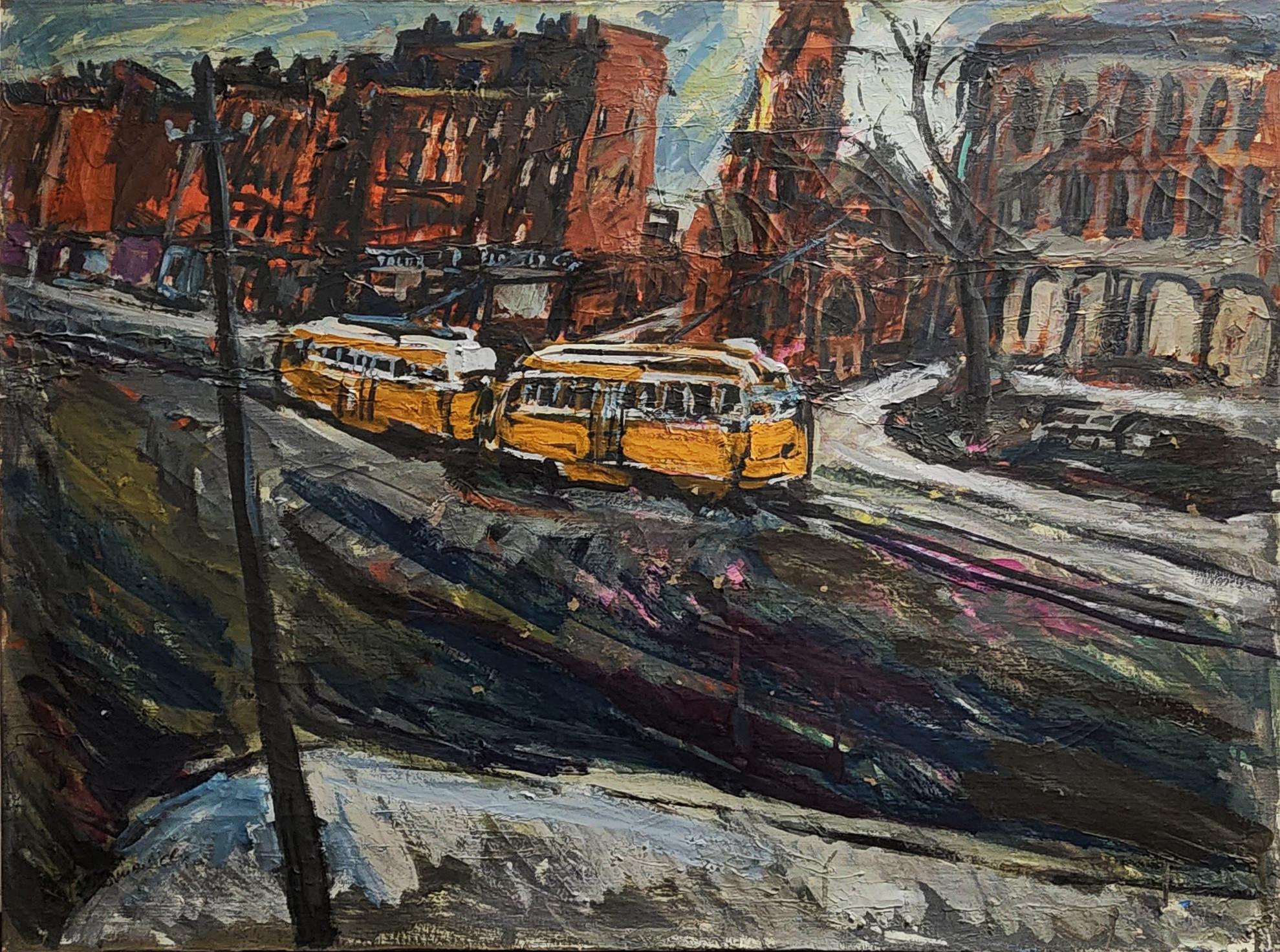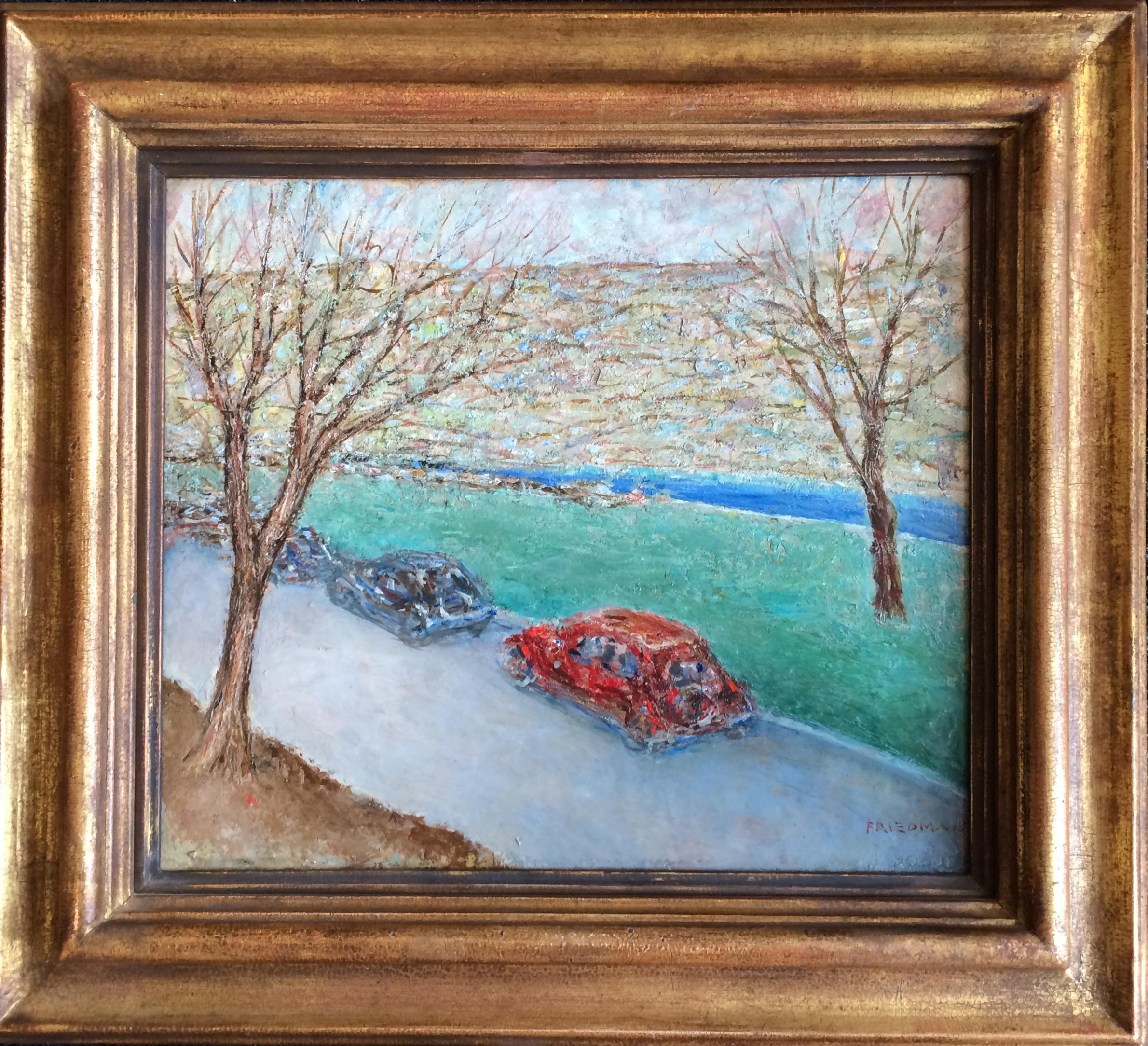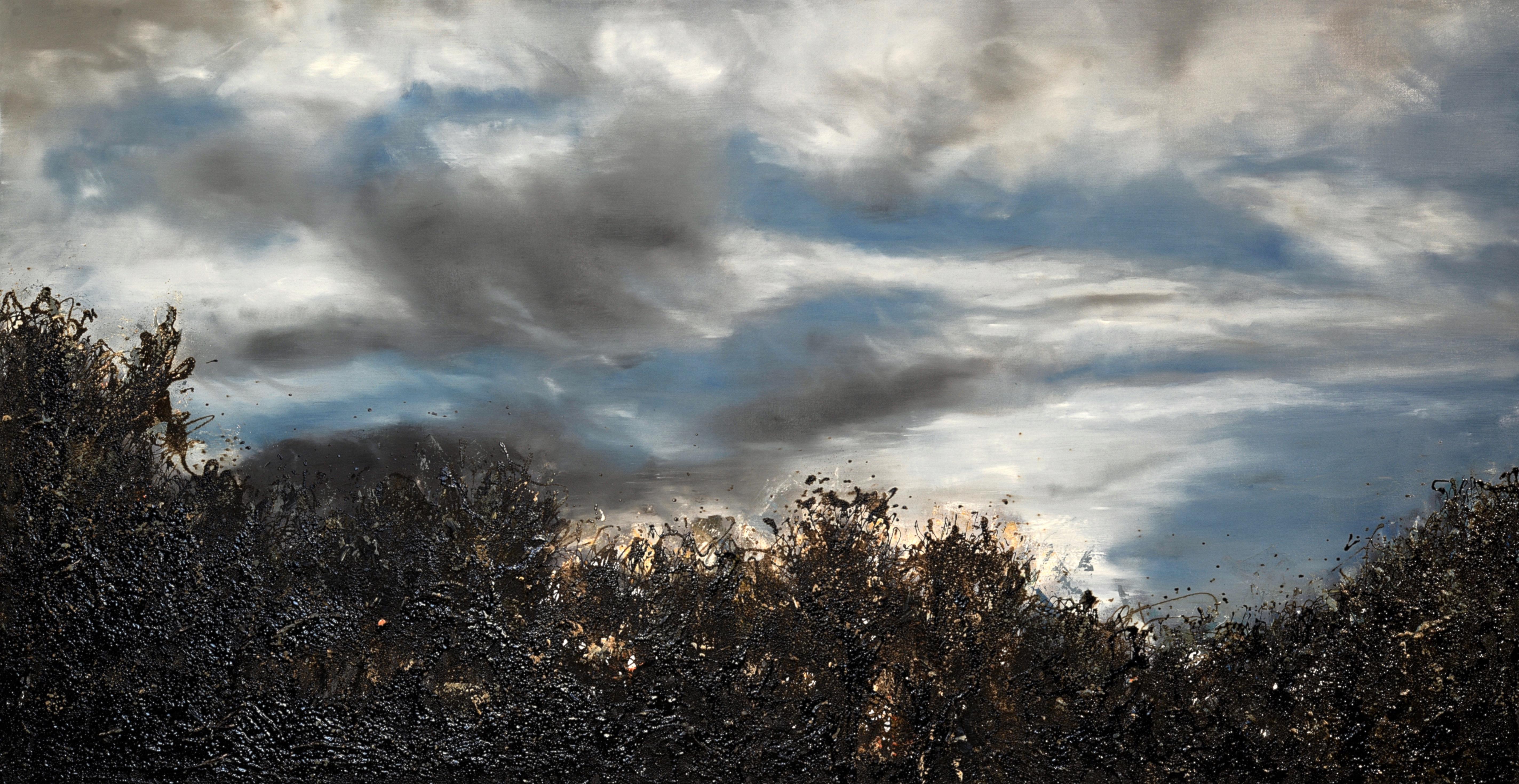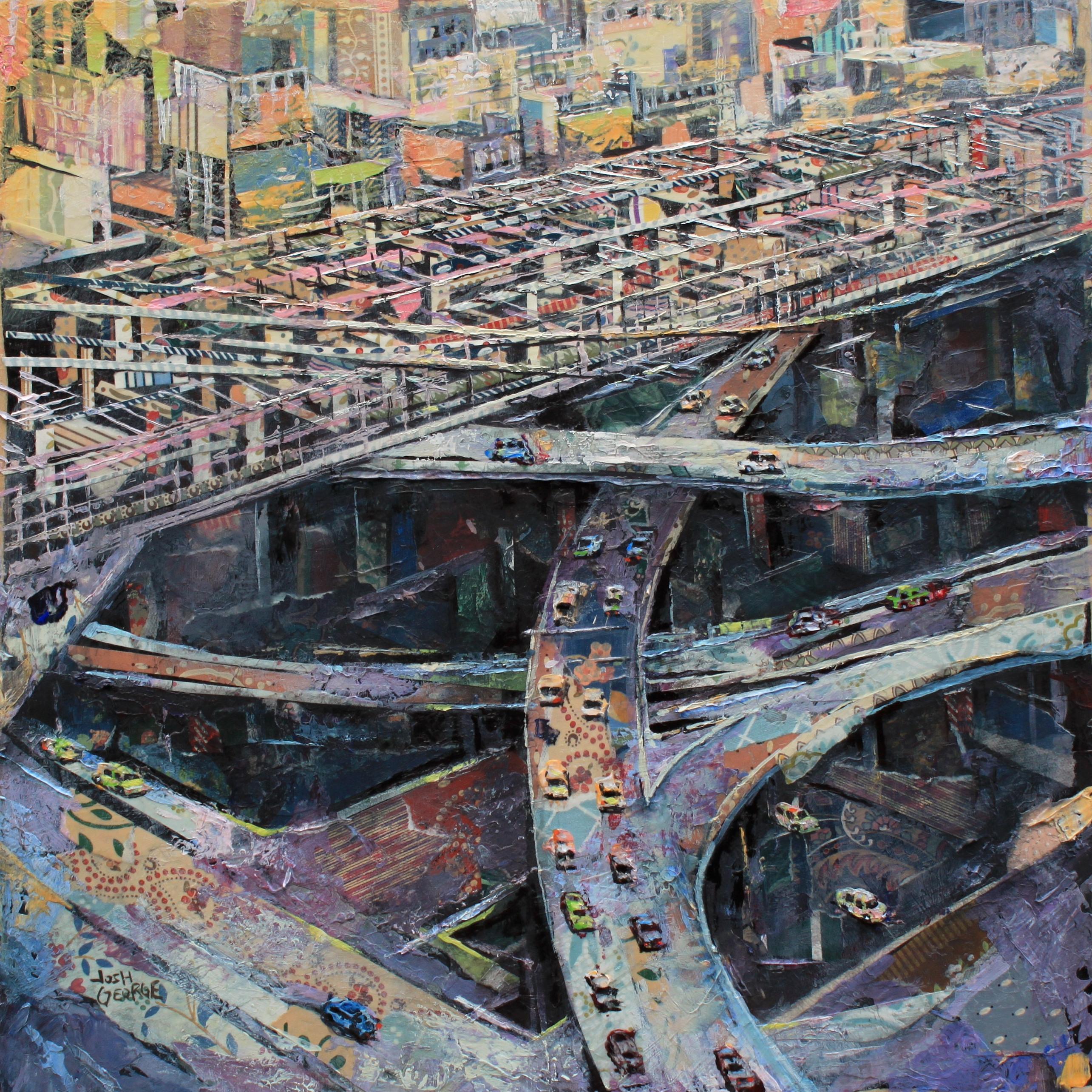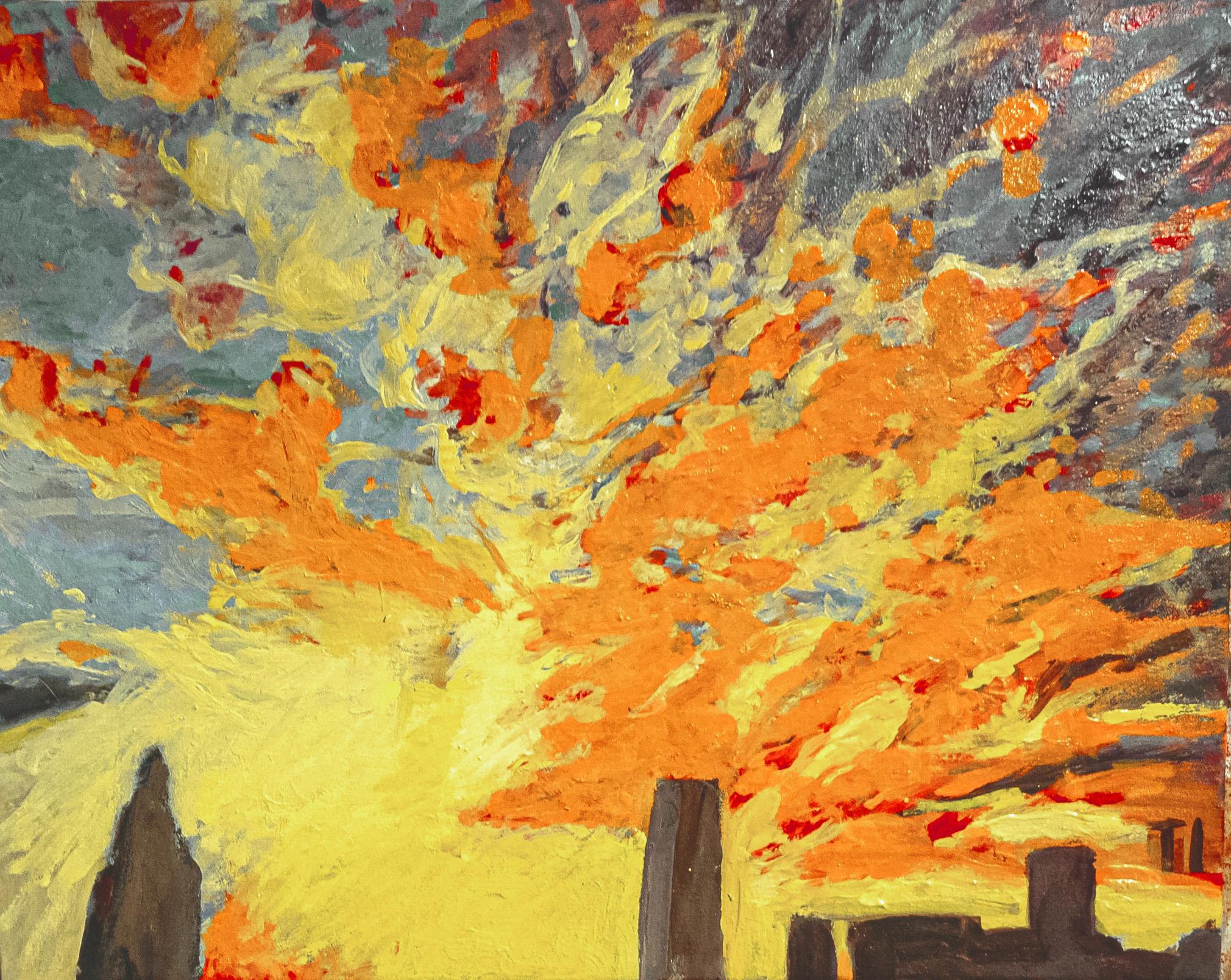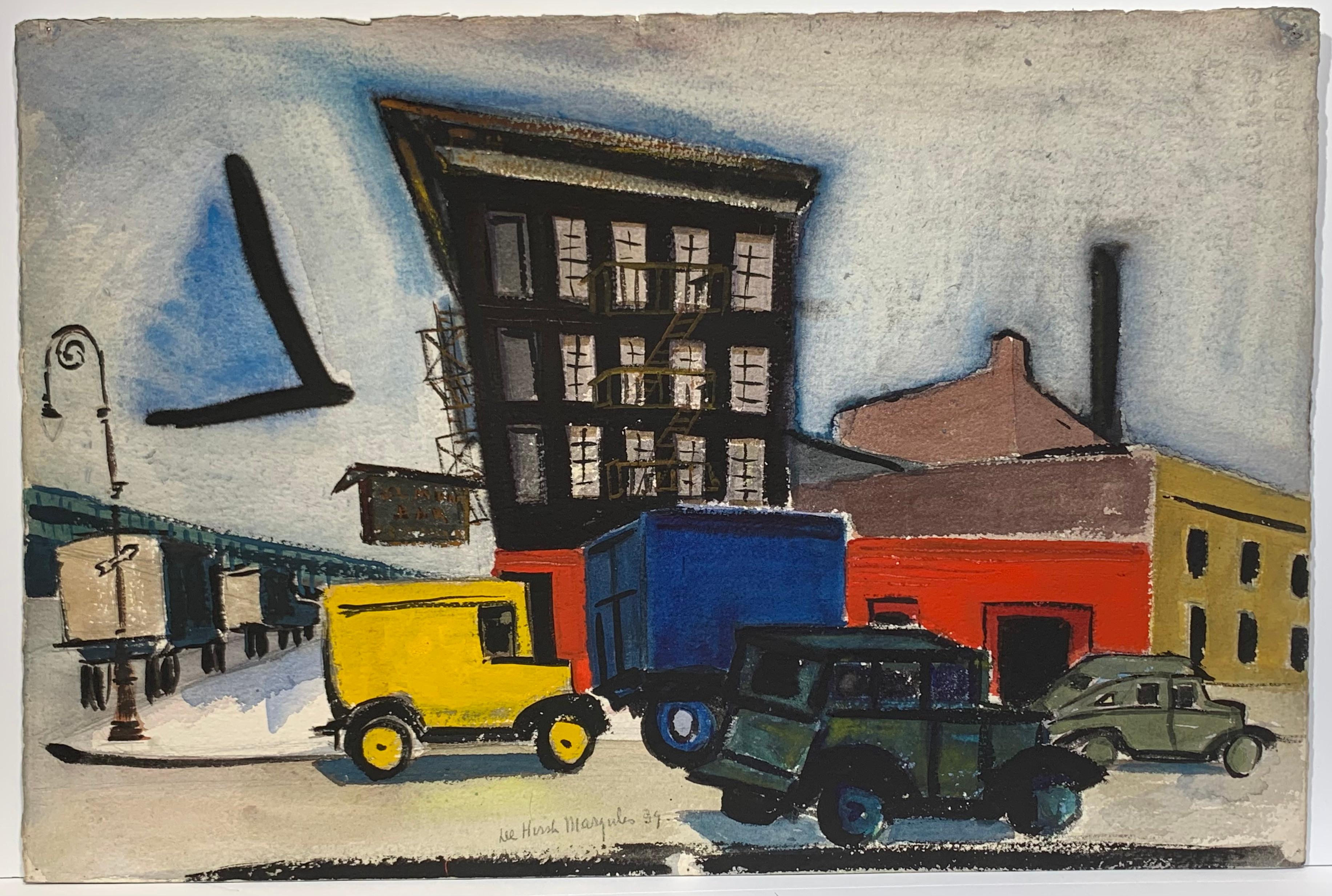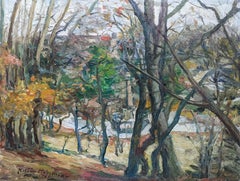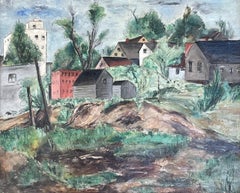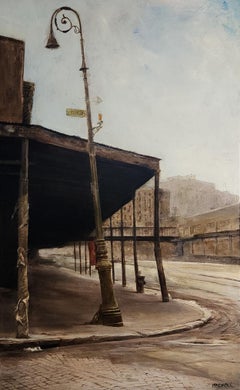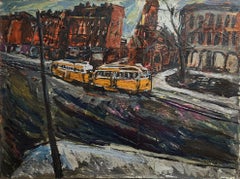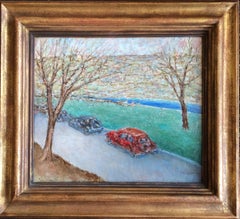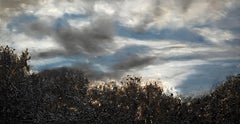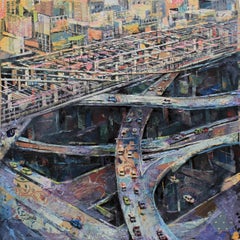Items Similar to "The Belt Parkway, " Lawrence Rothbort, Brooklyn, Cars, Textured Impasto
Want more images or videos?
Request additional images or videos from the seller
1 of 7
Lawrence Rothbort"The Belt Parkway, " Lawrence Rothbort, Brooklyn, Cars, Textured Impastocirca 1950
circa 1950
$28,000
$35,00020% Off
£21,227.85
£26,534.8120% Off
€24,470.09
€30,587.6220% Off
CA$39,433.51
CA$49,291.8820% Off
A$43,728.84
A$54,661.0620% Off
CHF 22,976.26
CHF 28,720.3320% Off
MX$534,292.14
MX$667,865.1820% Off
NOK 287,464.40
NOK 359,330.5020% Off
SEK 269,834.45
SEK 337,293.0620% Off
DKK 182,674.04
DKK 228,342.5620% Off
About the Item
Lawrence Rothbort
Belt Parkway, circa 1950
Oil on canvas
48 x 48 inches
Lawrence Rothbort was born March 1920 in Brooklyn, New York. He was a model from infancy for his father, American Impressionist Samuel Rothbort. A high school dropout at 16, he sought various trades with each experience ending in disappointment and dissatisfaction. In his late teens he became an avid reader of philosophy, religion and mysticism which, eventually, led him to become a moral vegetarian.
He was a Pacifist and would not serve in World War II; a requirement for not serving in the military was to work on American farms due to the manpower shortage. He spent the year 1944 through 1945 living in the Pocono woodlands as a hermit, closely observing nature and living off the land. In 1945, he experienced an epiphany and committed himself to becoming an artist. For the entire year of 1945 with the exception of 2 or 3 holidays, he executed a painting every single day even during the bitter cold. Rain or snow had him painting from life, but indoors. His father, artist Samuel Rothbort told him "Nature will teach him how to paint."
He chose to cut himself off from his contemporaries and created a difficult path for himself. The Charles Barzansky Gallery gave him his first one man show in 1947. The reviews were excellent comparing his drawings to the "old masters" "extraordinary" and his oils "outstanding", "admirably executed", "a Seurat painter", "most personal revelation of an arresting
talent"
Like his father, he recorded the ever changing landscape of New York, including 5th Avenue with flags - always on location and never touching up or finishing an outdoor work in the studio. He stated their "Direct Art was synonymous with truth."
He worked in oil, casein, pen & ink and glass. Depending upon the subject and medium, his work would take anywhere from 3 months to one and a half years; working every day for no less that 8 - 12 hours. In 1954, using discarded glass from the shores and junk piles, he embarked on a new phase in his career and began creating mosaics.
In 1956 he married a woman from Brooklyn (Marlene - unknown last maiden name) with whom he later had three children. At the end of 1956, he moved to Florida, and it was there that two of the three children were born. The demands of family life saw him work less and less at his art. He completed three major works, two large oils; one of his wife nursing their first born surrounded by everything they owned in their life. This huge major work done in oil, took him eighteen months to complete. He also did one still life mosaic and another oil painting of their son in a playground.
In 1963, in a store-based gallery and apartment, in an attempted robbery, Lawrence Rothbort was shot to death in front of his pregnant wife and two children ages 4 and 7 respectively. He had refused to give the assailant the last five dollars he had.
In February 1964, a memorial exhibit was held at the Riverside Museum and he received outstanding reviews. As a result of that exhibit some of his work is now in the Rose Museum at Brandeis University, the outstanding American collection of Dorothy and Murray Handwerker, Dr. & Mrs. Kaplan, Florence, Italy and many other collections.
Most of his work is not signed. Only some of his earlier pieces. However, Harriet Semegram, his friend and art dealer, cataloged and photographed his work and has authenticated them. He believed that the way he painted was entirely unorthodox, entirely original, only in some ways traced back to the Egyptians, could never be copied. As one reviewer wrote, "If some of the gallery visitors come looking for the birth of an American Van Gogh, not all of them go away disappointed."
- Creator:Lawrence Rothbort (1920-1963, American)
- Creation Year:circa 1950
- Dimensions:Height: 56.5 in (143.51 cm)Width: 56.5 in (143.51 cm)
- Medium:
- Movement & Style:
- Period:
- Condition:
- Gallery Location:New York, NY
- Reference Number:1stDibs: LU1841211550872
About the Seller
5.0
Platinum Seller
Premium sellers with a 4.7+ rating and 24-hour response times
Established in 2022
1stDibs seller since 2022
120 sales on 1stDibs
Typical response time: <1 hour
- ShippingRetrieving quote...Shipping from: New York, NY
- Return Policy
Authenticity Guarantee
In the unlikely event there’s an issue with an item’s authenticity, contact us within 1 year for a full refund. DetailsMoney-Back Guarantee
If your item is not as described, is damaged in transit, or does not arrive, contact us within 7 days for a full refund. Details24-Hour Cancellation
You have a 24-hour grace period in which to reconsider your purchase, with no questions asked.Vetted Professional Sellers
Our world-class sellers must adhere to strict standards for service and quality, maintaining the integrity of our listings.Price-Match Guarantee
If you find that a seller listed the same item for a lower price elsewhere, we’ll match it.Trusted Global Delivery
Our best-in-class carrier network provides specialized shipping options worldwide, including custom delivery.More From This Seller
View All"Prospect Park, Brooklyn, " Nathan Hoffman, New York City Impressionist Landscap
Located in New York, NY
Born in Russia, the son of Friede (1878 – 1956) and Benjamin Hoffman (1878 – a. 1942). Benjamin was a dealer in mineral and seltzer water and the family resided on Snediker Avenue in Brooklyn, New York, just down the streetfrom the home where George Gershwin (1898 – 1937) was born.
This area of Brooklyn, known as Brownsville, “witnessed the development of one of the largest communities of Eastern European Jewish immigrants during the last decade of the 19th century and the first two decades of the 20 th century.” Today, little remains of this once thriving Jewish section of Brooklyn, which today houses many commercial and repair businesses.
Hoffman studied at the Art Students League of New York, the National Academy of Design and in the art program at Cooper Union. His work at the National Academy received praise, and in 1921 he was awarded the 2nd prize and an honorable mention from the John Armstrong Chaloner Paris Prize Foundation at the National Academy, which allowed the recipient to study in Paris, France for as long as five years. The following year he was awarded the 1 st prize in the competition (with The Reform Advocate running the headline “Young Jew Wins Art Prize”) as well as the Suydam Bronze Medal for his achievements in the Academy’s Men’s Night Class. In 1923 he was residing in Long Branch, New Jersey, when he was awarded 4th place in the Chaloner competition.
Early on, Hoffman exhibited his work throughout the city, including in 1925 with the recently organized Society of Independent Artists. He also received several solo exhibitions during the first part of his career, including one at Ferargil Galleries in 1929. In the spring of 1930 a solo exhibition of his portraits, including paintings and drawings, was held at at Babcock Galleries, where a reviewer noted: “Portraiture is obviously Mr. Hoffman’s specialty… his best work is characterized by a sensitive appreciation of character set down in a vigorous decisive statement.
Later that same year, in August, he participated in Babcock’s summer exhibition where reviewer Jerome Klein, writing for The Baltimore Sun, felt Hoffman’s and other artists work was already becoming old fashioned, remarking “…if an effort toward accomplishment is to be made, it must be in the language of today. It is for that reason that such contemporaries as Eugene Higgins and Nathan Hoffman, in this show, seem artists of a bygone era…” The onset of the Great Depression appears to have slowed his success, as was the case for many up-and-coming artists.
By 1939 Hoffman had become a gallerist in addition to being a painter, operating the collective exhibition space “Sutton Gallery,” which was originally located at 358 East 57th Street. There Hoffman exhibited his own works as well as those created by other prominent New York artists including David Burliuk (1882 – 1967), Charles C. Curran (1861 – 1942), Louis Eilshemius (1864 – 1941), Ann Goldthwaite (1869 – 1944), Maurice Kish (1895 – 1987), Lawrence Lebduska (1894 – 1966), Bradford Perin and Ellis Wilson...
Category
1940s Post-Impressionist Landscape Paintings
Materials
Oil, Board
"Backyard, Staten Island, New York" Bumpei Usui, Japanase-American Landscape
Located in New York, NY
Bumpei Usui
Backyard, Staten Island, 1933
Signed lower right
Oil on canvas
20 x 24 inches
Provenance:
The artist's estate
Salander O'Reilly Galleries, New...
Category
1930s American Realist Landscape Paintings
Materials
Canvas, Oil
"Shanties in the Bronx, New York" Bumpei Usui, Japanase-American City Landscape
Located in New York, NY
Bumpei Usui
Shanties in the Bronx, 1933
Signed lower right
Oil on canvas
14 x 20 inches
Provenance:
The artist's estate
Salander O'Reilly Galleries, New Y...
Category
1930s American Realist Landscape Paintings
Materials
Canvas, Oil
"10th Avenue, Meatpacking District" Harry McCormick, New York City Urban Scene
By Harry McCormick
Located in New York, NY
Harry McCormick
10th Avenue, Meatpacking District, New York
Signed lower right
Oil on masonite
23 7/8 x 15 inches
Renowned for his exquisite depiction of light and shadow, Harry Mc...
Category
1970s Contemporary Landscape Paintings
Materials
Masonite, Oil
"Ocean Parkway Beach, October 2" Nathan Hoffman, Brooklyn, Impressionist
Located in New York, NY
Nathan Hoffman
Ocean Parkway Beach, October 2, 1941
Signed, titled, dated on the reverse
Oil on artists board
9 3/4 x 14 inches
Born in Russia, the son...
Category
1940s American Impressionist Landscape Paintings
Materials
Oil, Board
"The Beach" Nathan Hoffman, Brooklyn, New York, Sunny Day Landscape
Located in New York, NY
Nathan Hoffman
The Beach
Estate stamped on the reverse
Oil on artist's board
10 1/4 x 14 inches
Provenance:
Estate of the artist
Born in Russia, the s...
Category
1940s American Impressionist Landscape Paintings
Materials
Oil, Board
You May Also Like
Electro Car Go (American Post-War, Impressionist, Boston, Streetcar, Tram)
Located in Kansas City, MO
Alex Tschernjawski
Electro Car Go (American Post-War, Impressionist, Boston, Streetcar, Tram, Cityscape, Blue Hill, Dorchester, Mattapan Square, Fra...
Category
1960s Post-War Landscape Paintings
Materials
Canvas, Oil
Autumn Day Drive oil painting by Arnold Friedman
By Arnold Friedman
Located in Hudson, NY
Painting size 12 ½" x 14 ½", framed 18" x 20 ¼" x 2"
Signed "Friedman" lower right
Inscribed verso: "Title: Autumn Day Drive. Associated impressions of two drives Hudson River and F...
Category
1930s Modern Landscape Paintings
Materials
Oil, Panel
On the Road / Oil on Linen with impasto tar
By Frédéric Choisel
Located in Burlingame, CA
On the Road, feels like a smooth drive in the countryside, impasto tar showing the impressionistic vegetation racing along against a blue sky filled with floating grey and white clou...
Category
21st Century and Contemporary Abstract Impressionist Abstract Paintings
Materials
Linen, Oil
"Ride Type" by Josh George, Mixed Media Painting, City Highway Interchange
By Josh George
Located in Denver, CO
Josh George's (US based) "Ride Type" is an original, handmade mixed media painting that depicts an urban cityscape, of highway interchanges.
About the Artist:
Josh George is a cont...
Category
2010s American Impressionist Landscape Paintings
Materials
Mixed Media, Wood Panel
Brooklyn 1990
By Tom Irizarry Studio
Located in Booklyn, NY
One of the tallest buildings in Brooklyn was The Williamsburg Savings Bank. I was always fond of this beautiful bank adorned in blue and multi colored tiles in it's lavish hallway....
Category
2010s Expressionist Landscape Paintings
Materials
Oil, Pigment
North on West Street (West Side Highway NYC Cityscape)
By De Hirsch Margules
Located in Wilton Manors, FL
De Hirsh Margules (1899-1965). North on West Street , 1939. Watercolor on Arches wove paper. Signed and dated in pencil by artist lower margin. Sheet measures 15 x 22 inches. Framed measurement: 27 x 34 inched. Incredibly vibrant and saturated color with no fading or toning of sheet.
Provenance: Babcock Galleries, NYC
De Hirsh Margules (1899–1965) was a Romanian-American "abstract realist" painter who crossed paths with many major American artistic and intellectual figures of the first half of the 20th century. Elaine de Kooning said that he was "[w]idely recognized as one of the most gifted and erudite watercolorists in the country". The New York Times critic Howard Devree stated in 1938 that "Margules uses color in a breath-taking manner. A keen observer, he eliminates scrupulously without distortion of his material." Devree later called Margules "one of our most daring experimentalists in the medium"
Margules was also a well-known participant in the bohemian culture of New York City's Greenwich Village, where he was widely known as the "Baron" of Greenwich Village.[1] The New York Times described him as "one of Greenwich Village's best-known personalities" and "one of the best known and most buoyant characters about Greenwich Village.
Early Life
De Hirsh Margules was born in 1899 in the Romanian city of Iași (also known as Iasse, Jassy, or Jasse). When Margules was 10 weeks old, his family immigrated to New York City. Both of his parents were active in the Yiddish theater, His father was Yekutiel "Edward" Margules, a "renowned Jewish actor-impresario and founder of the Yiddish stage." Margules' mother, Rosa, thirty-nine years younger than his father, was an actress in the Yiddish theater and later in vaudeville. Although Margules appeared as a child actor with the Adler Family[11] and Bertha Kalich, his sister, Annette Margules, somewhat dubiously continued in family theater and vaudeville tradition, creating the blackface role of the lightly-clad Tondelayo (a part later played on film Hedy Lamarr) in Earl Carroll's 1924 Broadway exoticist hit, White Cargo. Annette herself faced stereotyping as an exotic flower: writing about her publicist Charles Bouchert stated that "Romania produces a stormy, temperamental type of woman---a type admirably fitted to portray emotion." His brother Samuel became a noted magician who appeared under the name "Rami-Sami." Samuel later became a lawyer, representing magician Horace Goldin, among others. A family portrait including a young De Hirsh, a portrait of Rosa and Annette together, and individual photos of Rosa and Edward can be found on the Museum of the City of New York website.
At around age 9 or 10, Margules took art classes with the Boys Club on East Tenth Street, and his first taste of exhibition was at a student art show presented by the club. By age 11, he had won a city-wide prize (a box camera) at a children's art show presented by the department store Wanamakers.
As a young teenager, Margules was already displaying a characteristic kindness and loyalty. Upon hearing that two friends (one of them was author Alexander King), were in trouble for breaking a school microscope, the nearly broke Margules gave them five dollars to repair the microscope . Margules had to approach a wealthy man that Margules had once saved on the subway from a heart attack. Margules didn't reveal the source of the five dollars to King until twenty-five years later.
In his late teens, Margules studied for a couple of months in Pittsburgh with Edwin Randby, a follower of Western painter Frederic Remington. Thereafter he pursued a two-year course of studies in architecture, design and decoration at the New York Evening School of Art and Design, while working as a clerk during the day at Stern's Department Store. He was encouraged in these artistic pursuits by his neighbor, the painter Benno Greenstein (who later went by the name of Benjamin Benno).
Artistic career
In 1922, Margules began work as a police reporter for the City News Association of New York .Margules then considered himself something of an expert on art, and the painter Myron Lechay is said to have responded to some unsolicited analysis of his work with the remark "Since you seem to know so much about it, why don't you paint yourself?" This led to study with Lechay and a flurry of painting.
Margules' first show was in 1922 at Jane Heap's Little Review Gallery. Thereafter Margules began to participate in shows with a group including Stuart Davis, Jan Matulka, Buckminster Fuller (exhibiting depictions of his "Dymaxion house") in a gallery run by art-lover and restaurateur Romany Marie on the floor above her cafe.
Jane Heap, left, with Mina Loy and Ezra Pound
During the 1920s, Margules traveled outside of the country a number of times. In 1922, with the intent of reaching Bali, he took a job as a "'wiper on a tramp steamer where [he] played nursemaid to the engine." He reached Rotterdam before he turned back. He would return to Rotterdam shortly thereafter.
In 1927, Margules took a lengthy leave of absence from his day job as a police reporter in order to travel to Paris, where he "set up a studio in Montmartre's Place du Tertre, on the top floor of an almost deserted hotel, a shabby establishment, lacking both heat and running water." He studied at the Louvre and traveled to paint landscapes in provincial France and North Africa.
Margules also joined the "Noctambulist" movement and experimented with painting and showing his artwork in low light.Jonathan Cott wrote that:
the painter De Hirsch Margulies sat on the quays of the Seine and painted pictures in the dark. In fact, the first exhibition of these paintings, which could be seen only in a darkened room, took place in [ Walter Lowenfels'] Paris apartment.
Elaine de Kooning remarked that studying the works of the Noctambulists confirmed Margules' "direction toward the use of primary colors for perverse effects of heavy shadow."
It was also in Paris that Margules initially conceived his idea of "Time Painting", where a painting is divided into sectors, each representing a different time of day, with color choices meant to evoke that time of day.
In Paris, his social circle included Lowenfels, photographer Berenice Abbott, publisher Jane Heap, composer George Anthiel, sculptor Thelma Wood, painter André Favory, writer Norman Douglas, writer and editor George Davis, composer and writer Max Ewing, and writer Michael Fraenkel.
Upon his return to New York in 1929, Margules attended an exhibition of John Marin's paintings.
While at the exhibition, he "launched into an eloquent explanation of Marin to two nearby women", and was overheard by an impressed Alfred Stieglitz. The famous photographer and art promoter invited Margules to dine with his wife, the artist Georgia O'Keeffe, and his assistant, painter Emil Zoler. Stieglitz thereafter became a friend and mentor to Margules, becoming for him "what Socrates was to his friends."
Alfred Stieglitz
Stieglitz introduced Margules to John Marin, who quickly became the most important painterly influence upon Margules. Elaine de Kooning later noted that Margules was "indebted to Marin and through Marin to Cézanne for his initial conceptual approach - for his constructions of scenes with no negative elements, for skies that loom with the impact of mountains." Margules himself said that Marin was his "father and ... academy." The admiration was by no means unreciprocated: Marin said that Margules was "an art lover with abounding faith and sincerity, with much intelligence and quick seeing." Stieglitz also introduced Margules to many other artistic and intellectual figures in New York.
With the encouragement of Alfred Stieglitz, Margules in 1936 opened a two-room gallery at 43 West 8th Street called "Another Place." Over the following two years there were fourteen solo exhibitions by Margules and others, and the gallery was well-respected by the press. It was in this gallery that the painter James Lechay, Myron's brother, exhibited his first painting.
In 1936, Margules first saw recognition by major art museums when both the Museum of Modern Art and the Museum of Fine Arts, Boston purchased his works.
In 1942, Margules gave up working as a police reporter, and apparently dedicated himself thereafter solely to an artistic vocation.
"The Baron of Greenwich Village"[edit]
Margules made his mark not only as an artist, but also as an outsized personality known throughout Greenwich Village and beyond.
To local residents, Margules was known as the "Baron", after Baron Maurice de Hirsch, a prominent German Jewish philanthropist. Margules was easily recognizable by the beret he routinely wore over his long hair. Writer Charles Norman said that he "dressed with a flair for sloppiness."
He was said to "know everybody" in Greenwich Village, to the extent that when the novelist and poet Maxwell Bodenheim was murdered, Margules was the first one the police sought to identify the body. Margules' letters show him interacting with art world figures such as Sacha Kolin, John Marin and Alfred Stieglitz, as well as with prominent figures outside the art world such as polymath Buckminster Fuller and writer Henry Miller.
Most of his friends and acquaintances found Margules a generous and voluble man, given to broadly emotionally expressive gestures and acts of kindness and loyalty. In 1929, he exhibited an example of this loyalty and fellow-feeling when he appeared in court to fight what the wrongful commitment of his friend, writer and sculptor Alfred Dreyfuss, who appeared to have been a victim of an illicit attempt to block an inheritance.
The Greenwich Village chronicler Charles Norman described the bone-crushing hugs that Margules would routinely bestow on his friends and acquaintances, and speaks of the "persuasive theatricality" that Margules seemed to have inherited from his actor parents. Norman also wrote about Margules' routine acts of kindness, taking in homeless artists, constantly feeding his friends and providing the salvatory loan where needed. Norman also notes that Margules was blessed with a loud and good voice, and was apt to sing an operatic air without provocation.
The writer and television personality Alexander King said
I think the outstanding characteristics of my friend's personality are affirmation, emphasis, and overemphasis. He chooses to express himself predominantly in superlatives and the gestures which accompany his utterances are sometimes dangerous to life and limb. Of the bystanders, I mean.
King also spoke with affectionate amusement about Margules' pride in his cooking, speaking of how "if he should ever invite you to dinner, he may serve you a hamburger with onions, in his kitchen-living room, with such an air of gastronomic protocol, such mysterious hints and ogliing innuendoes, as if César Ritz and Brillat-Savarin had sneaked out, only a moment before, with his secret recipe in their pockets."
Margules was such a memorable New York personality that comic book writer Alvin Schwartz imagined him at the Sixth Avenue Cafeteria in a risible yet poignant debate with Clark Kent about whether Superman had the ability to stop Hitler.
Margules' entrenchment in the Greenwich Village milieu can be seen in a photograph from Fred McDarrah's "Beat Generation Album" of a January 13, 1961 writers' and poets' meeting to discuss "The Funeral of the Beat Generation", in Robert Cordier [fr]'s railroad flat at 85 Christopher Street. Among the people in the same photograph are Shel Silverstein...
Category
1930s American Modern Abstract Paintings
Materials
Watercolor, Rag Paper
$6,000 Sale Price
20% Off
More Ways To Browse
Cars Italian
Italian Car
Vintage Car Signs
Vintage Car Painting
Cold War Art
Vintage World Flags
Vintage Maidens
Landscape Oil Painting Egypt
1950 Rose Painting
The Offs First Record
Vintage Car Drawing
Impressionist Painting Flags
Harriet Oil Painting
Italy Flag Vintage
Vintage Playground
Pregnant Woman
Charles Rain
Greece Landscape Oil Painting
